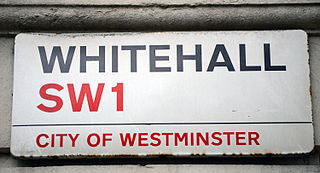Related Research Articles

Poetry, also called verse, is a form of literature that uses aesthetic and often rhythmic qualities of language − such as phonaesthetics, sound symbolism, and metre − to evoke meanings in addition to, or in place of, a prosaic ostensible meaning. A poem is a literary composition, written by a poet, using this principle.
A rhyme is a repetition of similar sounds in the final stressed syllables and any following syllables of two or more words. Most often, this kind of perfect rhyming is consciously used for a musical or aesthetic effect in the final position of lines within poems or songs. More broadly, a rhyme may also variously refer to other types of similar sounds near the ends of two or more words. Furthermore, the word rhyme has come to be sometimes used as a shorthand term for any brief poem, such as a nursery rhyme or Balliol rhyme.

A syllable is a unit of organization for a sequence of speech sounds typically made up of a syllable nucleus with optional initial and final margins. Syllables are often considered the phonological "building blocks" of words. They can influence the rhythm of a language, its prosody, its poetic metre and its stress patterns. Speech can usually be divided up into a whole number of syllables: for example, the word ignite is made of two syllables: ig and nite.
Alliteration is the repetition of initial consonant sounds of nearby words in a phrase, often used as a literary device. An example is "Peter Piper picked a peck of pickled peppers".

A figure of speech or rhetorical figure is a word or phrase that intentionally deviates from ordinary language use in order to produce a rhetorical effect. Figures of speech are traditionally classified into schemes, which vary the ordinary sequence of words, and tropes, where words carry a meaning other than what they ordinarily signify.
Assonance is a resemblance in the sounds of words/syllables either between their vowels or between their consonants. However, assonance between consonants is generally called consonance in American usage. The two types are often combined, as between the words six and switch, in which the vowels are identical, and the consonants are similar but not completely identical. If there is repetition of the same vowel or some similar vowels in literary work, especially in stressed syllables, this may be termed "vowel harmony" in poetry.
Consonance is a stylistic literary device identified by the repetition of identical or similar consonants in neighboring words whose vowel sounds are different. Consonance may be regarded as the counterpart to the vowel-sound repetition known as assonance.
In rhetoric, a rhetorical device, persuasive device, or stylistic device is a technique that an author or speaker uses to convey to the listener or reader a meaning with the goal of persuading them towards considering a topic from a perspective, using language designed to encourage or provoke an emotional display of a given perspective or action. They seek to make a position or argument more compelling than it would otherwise be.

In prosody, alliterative verse is a form of verse that uses alliteration as the principle ornamental device to help indicate the underlying metrical structure, as opposed to other devices such as rhyme. The most commonly studied traditions of alliterative verse are those found in the oldest literature of the Germanic languages, where scholars use the term 'alliterative poetry' rather broadly to indicate a tradition which not only shares alliteration as its primary ornament but also certain metrical characteristics. The Old English epic Beowulf, as well as most other Old English poetry, the Old High German Muspilli, the Old Saxon Heliand, the Old Norse Poetic Edda, and many Middle English poems such as Piers Plowman, Sir Gawain and the Green Knight, and the Alliterative Morte Arthur all use alliterative verse.
In literature and writing, stylistically elements are the use of any of a variety of techniques to give an auxiliary meaning, ideas, or feeling to the literalism or written.
In Welsh-language poetry, cynghanedd is the basic concept of sound-arrangement within one line, using stress, alliteration and rhyme. The various forms of cynghanedd show up in the definitions of all formal Welsh verse forms, such as the awdl and cerdd dafod. Though of ancient origin, cynghanedd and variations of it are still used today by many Welsh-language poets. A number of poets have experimented with using cynghanedd in English-language verse, for instance Gerard Manley Hopkins. Some of Dylan Thomas's work is also influenced by cynghanedd.
The phonological history of the English language includes various changes in the phonology of consonant clusters.
Owing to its origin in ancient Greece and Rome, English rhetorical theory frequently employs Greek and Latin words as terms of art. This page explains commonly used rhetorical terms in alphabetical order. The brief definitions here are intended to serve as a quick reference rather than an in-depth discussion. For more information, click the terms.
In rhetoric, parechesis (παρήχησις) is the repetition of the same sound in several words in close succession.
In linguistics, scheme is a type of figure of speech that relies on the structure of the sentence, unlike the trope, which plays with the meanings of words.

Rakhine, also known as Arakanese, is a language of western Myanmar that is closely related to Burmese. Native to the Rakhine, Marma, it is spoken as a first language by one million people, and as a second language by a further million.
Dán Díreach is a style of poetry developed in Ireland from the 12th century until the destruction of the Irish clan system, Gaelic Ireland and the Bardic schools during the mid 17th-century. It was a complex form of recitative designed to be chanted to the accompaniment of a harp. This poetry was often delivered by a professional reciter called a reacaire (reciter) or marcach duaine. It was the specialised production of the professional poets known as Filidh (Seer). The complexities of the structure becomes more understandable when we consider that Irish poetry evolved primarily as an orally transmitted art. They were not intended to be read, but recited in public. Form, structure, rhythm and rhyme, intonation, and expression all play an essential part of the performance of poets. The aim was to amaze an audience with vocal virtuosity, knowledge, and spiritual depth. In this they must have succeeded as the Filidh came to be viewed with a sense of awe, respect and fear.
The term alliteration was invented by the Italian humanist Giovanni Pontano (1426–1503), in his dialogue Actius, to describe the practice common in Virgil, Lucretius, and other Roman writers of beginning words or syllables with the same consonant or vowel. He gives examples such as Sale Saxa Sonābant "the rocks were resounding with the salt-water" or Anchīsēn Agnōvit Amīcum "he recognised his friend Anchises" or Multā Mūnīta Virum Vī "defended by a great force of men".
Poetic devices are a form of literary device used in poetry. Poems are created out of poetic devices composite of: structural, grammatical, rhythmic, metrical, verbal, and visual elements. They are essential tools that a poet uses to create rhythm, enhance a poem's meaning, or intensify a mood or feeling.
References
- ↑ Burton, Gideon. "paroemion". rhetoric.byu.edu. Retrieved 2023-03-28.
- ↑ Dubow, Bethany (2022-01-01). "Toadstool Poetics: Alliteration in The Faerie Queene". Spenser Studies. 36: 100–104. doi:10.1086/717092. ISSN 0195-9468.